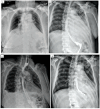Boerhaave Syndrome-Narrative Review
- PMID: 41095682
- PMCID: PMC12524210
- DOI: 10.3390/diagnostics15192463
Boerhaave Syndrome-Narrative Review
Abstract
Boerhaave syndrome (BS) and subsequent septic mediastinitis represent a complex cascade of events from esophageal perforation to septic shock. The pathophysiology involves chemical injury, polymicrobial contamination, cytokine storm, endothelial dysfunction, coagulation disorders, and ultimately multiple organ failure. Understanding these mechanisms is crucial for proper therapeutic management that can interrupt this lethal sequence. Due to the complexity of this condition, it is almost impossible to develop a feasible treatment protocol for every situation. The article, through a literature review, evaluates the pathophysiological mechanisms, the consequences of spontaneous esophageal rupture, as well as the therapeutic techniques available for these situations. These elements are the basis of the management of spontaneous esophageal rupture, which involves adapting and customizing the treatment for each patient.
Keywords: Boerhaave syndrome; endoscopic treatment; esophageal perforation; esophageal rupture; mediastinitis.
Conflict of interest statement
The authors declare no conflicts of interest.
Figures











References
Publication types
LinkOut - more resources
Full Text Sources

